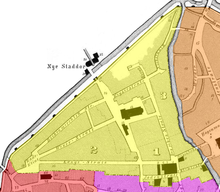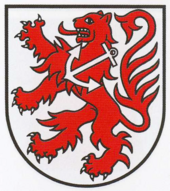Neustadt (Braunschweig)

The precincts of Neustadt is the northernmost of the five precincts of medieval Braunschweig . It had had its own council constitution since 1257 at the latest.
history
Emergence
The new town was laid out according to plan from around the year 1200, although it is disputed whether Henry the Lion was still involved in the planning of this part of town. The new town was first mentioned in 1231 as nova civitas in Bruneswich . The three main roads that shaped the new settlement area initially, were the Lange , the weaver and the Beck improvement road , of which the long road the settlement area with the Hagenmarkt union, but the other two together in the new wool market resulted. The Beckenwerkerstraße also continued to the Werderhafen, which served both the Neustadt and the Hagen area to make the Oker river flowing around and through Braunschweig navigable for barges. Initially, the actual market in Neustadt is said to have been located between the Neustadtrathaus and the Oker, but due to increasing construction activity, it was finally moved to the Wollmarkt.
Buildings and population
The new town is visually dominated by its parish church St. Andreas , which was built on the Wollmarkt from around 1225. In 1401 a scale was mentioned just a few meters to the south and the “ old scale ”, one of the most imposing half-timbered buildings in the city, was probably built on its site in 1534 . This house was completely destroyed by several bomb hits on February 10, 1944, as well as the fire storm of October 15, and its rubble was cleared after the war. From 1991 to 1994, however, it was partly rebuilt using original components and with the aid of the original construction plans. Again only a few meters away from the Andreaskirche, but this time in the east, is the Liberei , built between 1412 and 1422 , the only brick Gothic building in Braunschweig and probably the oldest free-standing library building north of the Alps.
Originally, the development around the Wollmarkt consisted almost exclusively of half-timbered houses that were close together, there were only a few stone buildings: next to the Liberei, the Achtermannsche Haus and the Neustadtrathaus. Since the Neustadt partly bordered directly on the Oker and is still crossed by some of its tributaries, there were also two mills in this district that have been in use since 1328. The stone Neustadtmühle on Neustadtmühlengraben still exists today.
The Neustadtor, built in 1433 especially for this settlement in the northwest, which was located between the older Petritor and the Wendentor and which protected a bridge over the Oker and the ramparts in its area, also belonged to the Neustadt . It was renewed in 1569 and closed forever on November 27, 1693, with the bridge being demolished. The Neustadttor was finally removed in 1793.
The Braunschweiger Neustadt, in the corner between the old town and Hagen, has developed since its foundation in the beginning of the 13th century to a decidedly industrial location and one of the "front soft images" of Braunschweig.
Some merchants from the Weichbild Altstadt also lived here . But until about 1600 the population consisted mainly of craftsmen such as wool weavers and basin workers , as can still be seen today from the street names Wollmarkt, Weberstraße, Beckenwerkerstraße and Kupfertwete. Due to the fire hazard of their trade, the basin workers in Braunschweig, which were only available in a few cities, were exclusively dependent on this district.
The finished products, often also the raw materials required, were long-distance trade products.
Long-distance trade was largely taken over by “necessary people”, i.e. entrepreneurs and long-distance trade merchants. These were also the owners of the workshops who did not practice the craft themselves, where they let work as factory owners in the publishing system at their own expense. They were also members of the "advisable" guilds, which were among the oldest and most distinguished in Braunschweig.
The patrician and council families von Broitzem , Lutherdes (von Barberge), and later also Achtermann ( Achtermann's house ) are to be made famous here as long-distance wool and cloth traders, sheet makers and “garment tailors” .
With regard to the basin crafts in the Braunschweiger Neustadt, the entrepreneurial families from Adenstede, von Peine, von Schepenstidde and von Strombeck are particularly noteworthy. The van Twedorp family and Fricke van Twedorp to an extraordinary extent around 1400 stand out here.
Barward Tafelmaker , the builder of the Andreas church tower (1518), which was then the third highest tower in Europe and the Braunschweiger Wasserkünste (1530) , also lived in Neustadt .
Destruction in World War II
The Neustadt was almost completely destroyed by the air raids of the Second World War , in particular by the bombing on the night of October 15, 1944 . A few buildings were rebuilt until the 1990s, including the Alte Waage, the Achtermannsche Haus, the Neustadtrathaus, the Neustadtmühle and the Liberei. Other residential areas and streets in the Neustadt were so destroyed that they have completely disappeared from the cityscape today, such as the streets Nickelnkulk , Rehnstoben and Geiershagen together with their buildings.
The area was rebuilt according to the standards of a car-friendly city and partially as a modern residential area with apartment blocks in the countryside. Roads were widened and relocated and the old plots were redesigned.
coat of arms
Description: In the silver shield is a red, upright, red-tongued, black-armored lion with a silver anchor on the left .
Pictures from the new town
Andreas Church with old scales
Wollmarkt with St. Andrew's Church and Alter Waage
literature
- Camerer, Garzmann, Schuegraf, Pingel: Braunschweiger Stadtlexikon , Braunschweig 1992
- Manfred RW Garzman (ed.): The old scales in the Braunschweiger Neustadt. Excavation findings, history of the Weichbildes Neustadt, reconstruction and design of the square , in: Braunschweiger Werkstücke , Volume 87, Braunschweig 1993
- Jürgen Hodemacher : Braunschweig's streets - their names and their stories, Volume 1: Innenstadt , Cremlingen 1995
- Karsten Kablitz: The old scales in Braunschweig. Report on the settlement and building archaeological excavations on the grounds of the Alte Waage in Braunschweiger Neustadt from October 1988 to June 1989 , Braunschweig 1992
- Robert Slawski: St. Andreas - Neustadt - Braunschweig , Braunschweig 1996
Web links
- Historical maps on the urban development of Braunschweig on the website of the city of Braunschweig, PDF, accessed on November 4, 2012
Individual evidence
- ↑ Hartmut Rötting : Braunschweig in the High Middle Ages - the city of Henry the Lion? , 1996
- ↑ Joachim Lehrmann : Fricke van Twedorp / von Zweydorff - From the life of a patrician and basin worker entrepreneur in the Braunschweiger Neustadt - around 1400. In: Braunschweigische Heimat, 2016, Vol. I, pp. 8-19.
Coordinates: 52 ° 16 ' N , 10 ° 31' E











